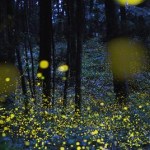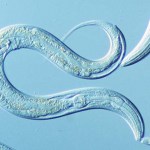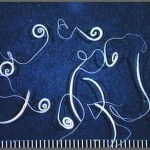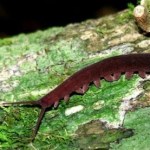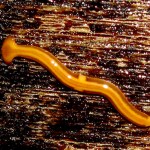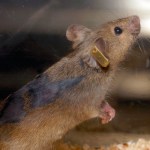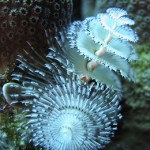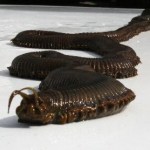worm
Jeff Cremer, a nature photographer, discovered mysterious tiny glow worms (~0.5 inches long) in Peru near the Tambopata Research Center a couple of years ago. Scientists still have not identified the species of these glow "worms", but suspect they are actually click beetle larvae. Entomologists Aaron Pomerantz, Mike Bentley, and Geoff Gallice from the University of Florida decided to go to Peru to investigate the worms. Here is what they found:
Image of C. elegans from http://www.easternct.edu/~adams/C.eleganslanding.html
New research published in PLOS Genetics shows that starving C. elegans (Caenorhabditis elegans) during the late larval stage of development when the worms are undergoing tissue growth and formation halts cellular activity at previously unknown checkpoints in their development. These findings show that nutrition is an important cue to signal whether or not the worms should continue on to the next stage of development. Interestingly, the two-week starvation period actually doubled the lifespan of the worms as…
Image from www.Nematode.net.Credit: http://www.latech.edu/ans/faculty-staff/liberatos-james-d/parasite-pict…
Believe it or not, scientists at Albert Einstein College of Medicine in collaboration with Coronado Biosciences are intentionally infecting people who have autism with whipworms from pigs (Trichuris suis), although generally considered non-pathogenic to humans.
For some individuals, an elevated inflammatory state contributes to repetitive and irritable behaviors associated with autism. Researchers have observed that allergic responses (measured by skin prick tests) are higher in…
Image of velvet worm from: Oliveira et al / Zoologischer Anzeiger
A new species of velvet worm (Eoperipatus totoros) is the first to be described from Vietnam after its discovery in 2010. This 2.5 inch long worm is distinguished from other velvet worms by hairs with unique shapes that cover its body. These animals are difficult to find and study because they are usually hiding in the moist soil to prevent dehydration. However, during the rainy season, they exit the soil and can be spotted. What is neat about these worms is that they hunt by spraying a glue-like…
Figure from Journal of Experimental Biology.
Researchers Tal Shomrat and Michael Levin at Tufts University have found that planaria worms are able to quickly relearn lost skills after literally losing their heads. The researchers trained the worms to find food in an environment with bright light and open space, both considered uncomfortable to the creatures. The time it took for worms to adjust to the environment and find food was recorded. Then, the researchers severed their heads and waited for the head and brain to regenerate (see image above). What…
Image of common model organisms from European Molecular Biology Laboratory (EMBL).
A recent article posted in the BBC News provided a good explanation of why scientists commonly study these organisms as models for human diseases and conditions. Model organisms are chosen because their physiology is similar to other animals, including humans, in addition to other reasons:
Visit the BBC News to see why researchers most often use flies, fish, mice and worms to understand the mechanisms of disease and health.
Did you know that ~70% of the genes in a…
Here are some images of Christmas Tree worms (Spirobranchus giganteus), just in time for the holidays:
Image Source: Ryan Photographic
Image Source: Ryan Photographic
Image Source: Ryan Photographic
These are tube-dwelling worms that live in coral reefs and use their spiral plumes for feeding and respiration.
Christmas Tree Worm Identification -- powered by ehow
Happy holidays!
Sources:
MarineBio
Images: Ryan Photographic
During chase scenes, movie protagonists often make their getaway by releasing some sort of decoy to cover their escape or distract their pursuer. But this tactic isn't reserved for action heroes - some deep-sea animals also evade their predators by releasing decoys - glowing ones.
Karen Osborn from the Scripps Institute of Oceanography has discovered seven new species of closely related marine worms (annelids) that use this trick. Each species pack up to four pairs of "bombs" near their heads - simple, fluid-filled globes that the worms can detach at will. When released, the "bombs" give…
Aesop's fable "The Crow and the Pitcher" has been confirmed in a wonderful experiment. In the classic tale, a thirsty crow uses stones to raise the level of water in a pitcher until it rises within reach of its beak. This is no mere fiction - rooks, close relatives of crows, have the brains to actually do this.
The aptly named Chris Bird, along with Nathan Emery, gave four captive rooks (Cook, Fry, Connelly and Monroe) a chance to reach a small worm floating in a cylinder of water, with nothing but a small pile of stones sitting on the side. All of them solved the task, and Cook and Fry…
by Katie the Lowly Intern
As a kid, I was always interested in bioluminescence:
So I can't really pass up the chance to post about beings that can produce their own light. Marine biologists at Scripps Institution of Oceanography at UC San Diego have been playing around with bioluminescent fireworms.
Odontosyllis phosphorea
Dimitri Deheyn and Michael Latz are trying to figure out how and why fireworms generate light producing proteins. Before releasing a mess of gametes, hot lady fireworms create a big cloud of glowing mucus which appears to attract male fireworms. Sexy. Deheyn and Latz…
For the last few months, a killer stalked the streets of Cornwall... or more specifically, the water of Cornwall, and even more specifically, the living reefs exhibit at Newquay's Blue Reef Aquarium. Day after day, aquarists would return to the award winning exhibit, only to find once healthy coral ripped apart - in some cases literally ripped in half.
Clues were few and a variety of traps yielded no results. When a gentle tang fish was found greviously injured, they called in Scotland Yard. On a side note, tang is delicious.
Reluctant to remember the incident, Curator Matt Slater finally…
"Worm grunting" is a curious but popular practice for harvesting earthworms in Florida's Apalachicola National Forest. To summon earthworms to the surface, worm grunters drive a wooden stake into the soil and vibrate it. Panicked worms pour out of the ground and thousands can be gathered in just a few hours. Lifelong worm grunters (and there are families that have been professional worm grunters for multiple generations) have a variety of theories regarding the underlying mechanisms of their trade. However, Kenneth Catania, a researcher from Vanderbilt, has come up with an explanation to this…
Marine biologists off the coast of Australia have discovered what they believe to be hundreds of new species on the Great Barrier and Ningaloo Reefs. The project is part of CReefs, a global census of coral reefs, which is in turn part of the larger Census of Marine Life, an ongoing effort to catalog all ocean life.
The researchers were kind enough to take a number of incredible photos, many of which we share below. It's not clear to me which of these are newly identified organisms and which are just pretty critters they encountered along the way, but many of them are spectacular regardless…
Zooillogix would like to take a moment to introduce you to Parborlasia corrugatus, a proboscis worm residing in the waters of Antarctica. We should note that we were inspired to learn more about these cute little fellows from this outstanding pic we saw on Ugly Overload.
Photo credit Jeff Miller
P. corrugatus grows up to two meters in length, comes in a variety of delightful colors, and kills its prey by rapidly and repeatedly stabbing it with a harpoon-like barbed proboscis! This proboscis has adhesive secretions which secure it in place. When threatened, this fast moving giant death worm…
Via a circuitous route, prompted by a friend of Zooillogix, Tweet Gainsborough-waring, I found myself looking at the picture below.
This otherworldly Australian earthworm, Terriswalkeris terraereginae, not only looks likes delicious candy, but the mucin it releases is luminescent, and it grows up to 2 meters long. I knew Zooillogix readers would want to know more about this fascinating critter but could find almost no information online. Luckily, Dr. Geoff Dyne, Assistant Director, Queensland Section, Australian Government Natural Research Management Team (and more importantly,…
Today, Zooillogix takes you deep inside Benny's colon to reveal a writhing round worm!
NOT FOR PEOPLE WITH WEAK STOMACHS
Ladies - Here's a tip. Benny is just as cute on the outside as the inside!
Thanks to Craig McClain for sharing?
Buddenbrockia plumatellae
Discovered in 1851, the Buddenbrockia worm has long confounded scientists--it seems like a worm, but has some very unworm-like characteristics. Unlike similar looking creatures, such as nematodes, the Buddenbrockia's body does not have separate organs. Its insides are totally symmetric. According to Professor Peter Holland of Oxford University,Aeos Department of Zoology as quoted in Physorg.com, "It doesn,Aeot have a left or right side or a top or bottom ,Aei we can,Aeot even tell which end is the front!...Seen in cross section it is completely symmetrical so no way…
This month marks Carl Linnaeus' 300th birthday and biology textbooks still look much the way he imagined they should. Linnaeus is the father of the ranking system of classifying the living world. You might remember kingdom, phylum, class, order, genus, species from the back of your hand in 9th grade biology class. Indeed, this system has stood up surprisingly well for almost two and a half centuries despite revolutionary advances in other scientific fields like medicine, where we now know that flu is not caused by a small gnome living in your stomach. Unfortunately for Linnaeus' legacy,…
Scientists are "baffled" by the discovery of a strange worm-like, serpentine creature off the cost of Juno Beach in Florida. Diver Jay Garbose caught the 7-10 foot creature on film as it slithered around the ocean floor. Watch his astonishing video footage.Unidentifiably delicious!
Garbose has dubbed the beast "the living intestine" because of its smooth, tube-like features. Some have ventured to say that it is a newly found species of Nemertean worm, but for now the Smithsonian Institute is labelling it "undescribed"...creative.
